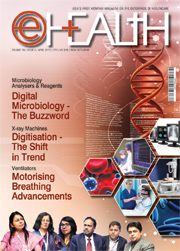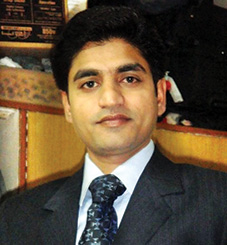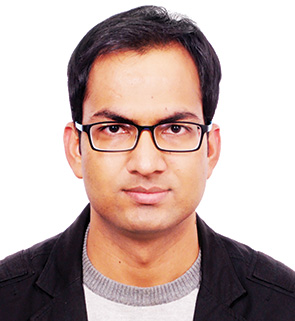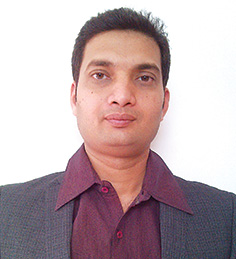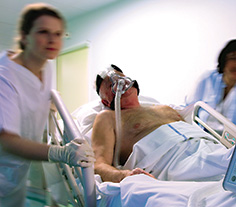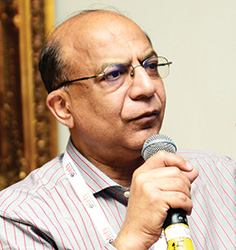

Principal Secretary, Medical Health and Family Welfare Department, Government of Uttar Pradesh
There are three major initiatives for which we are inviting public private participation: The Request for Proposal (RFP) for mSwasthya has already being floated, says Arvind Kumar, Principal Secretary, Medical Health and Family Welfare Department, Government of Uttar Pradesh.
Information Technology (IT) is basically bringing in transparency in the functioning of the government and empowering the citizens to know what their entitlements are. The IT revolution, especially after the coming up of the Right to Information (RTI) Act, has made the websites more informative. The department run websites also carry details of the schemes run by them. This opened a two way communications and this is what we have also attempted in healthcare sector in Uttar Pradesh.

At present, we are running various websites and trying to involve the public to tell them about their entitlements. Timely modification of these websites is also important to ensure service delivery and to engage with the stakeholders, directly giving them a clarification of their roles. One of the website that was launched recently was on the Pre-Conception and Pre-Natal Diagnostic Techniques (PCBNT) Act. This included the details of the ultrasound centres in various districts, their roles, and the registration of ultrasonologists. The aim of the website is to create public awareness and also provide them a platform through which they can inform the government about any irregularities, unregistered centres, so that appropriate action can be taken against them.
While improving the system efficiency one of the key problems that the department was facing is the lack of transparency in the availability of the medicines in the government hospitals. To solve this, various simple solutions are available in the inventory control and procurement. One of the solutions was developed by National Informatics Centre (NIC) locally and we have been able to implement it in the first stage. All the district hospitals and the CMOs have been computerised, stock of medicine have been made available online. There was also a lack of transparency with regard to the engagement with the suppliers. The suppliers were not able to find from which districts they have received the supply orders from, and when is the payment due to them. Hospitals were not informed about the dispatch of their supply and it was also difficult for us to know if they were not delivering. Now, this entire system is under transformation as far as the medicine availability and the procurement is concerned.
There are three major initiatives for which we are inviting public private participation: The Request for Proposal (RFP) for mSwasthya has already being floated. We have about 1.25 lakh ASHAs (Accredited Social Health Activists) working in Uttar Pradesh and they are supposed to be engaged with the ANMs (Auxiliary Nurse Midwife) and the medical officers. This solution ensures how a seamless data flow can be enabled from ASHAs to ANMs and then this data can be utilised by both medical officer and the higher level supervisory officers. Second initiative and subsequent participation with the private sector that we are opening is with regard to the running the mobile medical unit which is under the National Health Mission Scheme (NHMS) and we are in the process of launching about 150 mobile medical units through public-private- participation. Another initiative of the department is for the quality upgradation of the 155 district hospitals in the state. Around 40 hospitals are picked to get National Accreditation Board for Hospitals & Healthcare (NABH) accreditation. One of the key elements is the diagnostic services available in the hospital and for these 40 hospitals we want to invite private participants. The RFP for these is under process and will be out shortly.

This project is utilising the smartphone and tablets that we intend to start in few districts where ASHAs can upload data, which can be then seen by ANMs also. Both ANMs and ASHAs are the key service providers and they are supposed to maintain a number of registers. The primary problem they face is maintaining so many registers that makes them unable to extract the data if they are visiting a village. They do not know if children are due for immunisation or pregnant women are due for ANC and PNC etc. This is an initiative where we want to deliver timely and appropriate care for pregnant and lactating mothers, for immunisation of pregnant women and also to identify the malnutrition children who need supplementary nutrition. One is the beneficiary care and the other is that we are not able to capture the data generated. Even if we are able to capture it we are unable to utilise it for the managerial decisions. So we want to bridge this gap through this solution.
Key features of mSwasthya to empower field level workers
As of know ANMs and ASHAs if they have any issues and want to discuss any problem they do not have any platform available. So this basically will be a solution where they can get an online resolution of their queries and also address queries of the beneficiaries. There will be an on demand audio and video training also of the ASHAs and ANMs through this solution. The beneficiaries can then get mobile alerts, will be able to schedule and plan their activities, and will be in a better position to monitor which are the ANMs who basically are delivery, kind of interactions with the beneficiaries etc and will be able to track the outcomes of various schemes also.
ASHAs and ANMs will be provided with smartphones and tablets. The private provider is supposed to bring in these with the entire solution. About 1,719 tablets and 10,252 Smartphones are to be provided to the field level workers. If the pilot project in the five districts becomes operational and successful it will be escalated to rest of the 75 districts. The problem faced by the department at present is that even if ASHA is able to deliver service she is not able to get her incentive on time. This solution will also be able to ensure that the ASHA is getting her incentive on time, in case not the supervisory officers and the higher level officer will be able to track. Similarly, we can track the incentives that are due to the beneficiaries.
The system integrator will be appointed for the time period of three years. He is then required to provide the software and hardware of the solution also, the training and handholding of the field level workers as they will not be able to know how to feed the data, how to utilise the Smartphone etc. The operation and maintenance of the system should also be looked after for the entire three years. So, this is a complete package which the service provider is required to provide us.
About 1,719 tablets and 10,252 Smartphones are to be provided to the field level workers. If the pilot project in the five districts becomes operational and successful it will be escalated to rest of the 75 districts
National mobile medical unit project
The objective is to provide outreach services through a mobile vehicle. This will not only be providing the diagnostic services but also some of the key service delivery needs to be ensured. These 150 medical units are to be pumped into 40 districts, which are high priority districts and the districts that are affected by the Japanese encephalitis, acute encephalitis syndrome cases. So minimum of five blocks are required to be picked up in each districts and these services are going to be run by the engagement of a private partner, who is required to bring in not only the mobile units but services as well. He is also required to provide HR and diagnostic facilities.
All the diagnostic facilities and the data generated by these 150 mobile medical units would require an IT solution, the GPS tracking for mobile vehicles, so that the scheduling, planning and diversion of these vehicles can be undertaken accordingly. This is the third project with regard to diagnostic labs and we are doing it with collaboration with World Bank. Tele-diagnostics is one of the areas of key applications of the IT we want to make use of it. There is a dearth of radiologist and the experts in the department and by utilising expertise available with the private partners we want this gap in healthcare service to get bridged. The model for diagnostics for the Below Poverty Line (BPL) patients the entire cost will be taken by the government and for the Above Poverty Line (APL) the cost will be taken care by the users itself.
Be a part of Elets Collaborative Initiatives. Join Us for Upcoming Events and explore business opportunities. Like us on Facebook , connect with us on LinkedIn and follow us on Twitter , Instagram.


